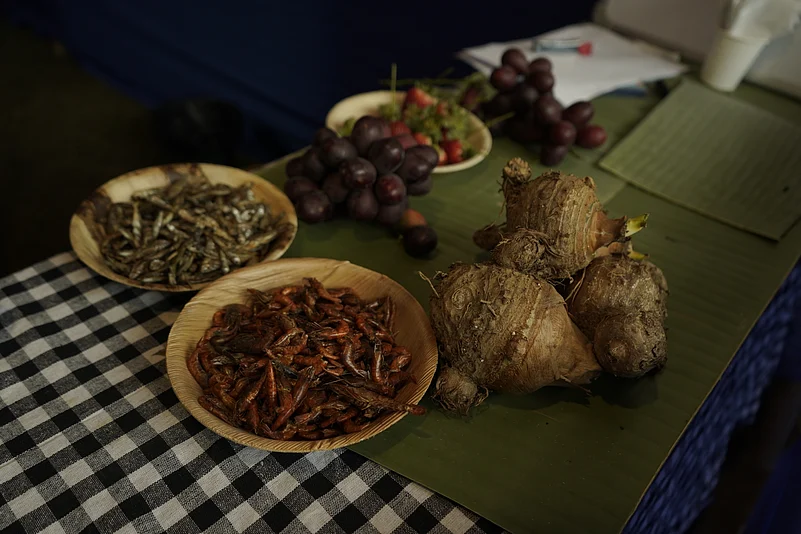We were strolling through the streets of a village in Ri-Bhoi district of Meghalaya, about halfway between Guwahati and Shillong. It was mid-morning, and we hadn’t had a chance to grab a bite yet. Through the many lanes inside a weekly farmers’ bazaar, we came across a kong shop (‘kong’ is Khasi for elder sister), a small canteen run by Khasi women. You’ll find places like these all across Meghalaya. They’re usually makeshift with a few benches squeezed into a small area, a kettle at the counter serving you some hot ‘sha saw’ (red tea, served without milk), along a selection of local dishes you can pick from behind the glass shelves. A step into the shop and you immediately get an iconic whiff of fermented bamboo shoots and meaty broths.
A typical breakfast in the Khasi region of Meghalaya is a pancake-like dish called putharo – made of rice, coconut and jaggery – and typically served with dohneiiong – a pork curry cooked with black sesame seeds. The sweetness from the rice and jaggery in putharo blends perfectly with the savouriness of the curry leaving a long-lasting, mouthwatering sensation on the tongue.
What an everyday meal for a Khasi home looks like is, however, very different from the food culture of the bustling city of Shillong, where much of the city is taken over by neat cafes, pubs and restaurants. It is only when one takes a tour in the maze of the mei-dominated (female elders) Iewduh market with its banana brokers, fresh fishmongers, honey hawkers, pickle peddlers, swine slaughterers, and tea traders that you get to witness the traditional food of Meghalaya.
Experiment your palette by taking a seat at the kong shops serving local delicacies, flavoured with no artificial tastemakers, just black sesame, ginger, garlic, onions and chillis, often smoked and prepared with bamboo shoots or meat. Like countless other stories of endangered culinary customs across the country, the traditional food, unique techniques, regional flavours and indigenous ingredients of the Northeast, too, need preserving.
Northeast is home to a huge tribal population and each tribe boasts of a unique culture, customs and cuisines. When it comes to food, the flavours, spices and techniques vary from region to region – sometimes even house to house – acquired from a rich melange of traditional knowledge passed on by generations, through folklores and family recipes. Given their vast forest cover – among the richest botanical habitats of Asia – northeastern tribes naturally had exposure to a variety of plants and plant products, resulting in a self-sustainable lifestyle for thousands of years. Animal products, in addition to that, provided the protein that was missing in the greens.
The geographical condition of northeast is such that many regions are also not easily accessible. As a result, people have for generations been dependent on their surroundings and traditionally utilise the ingredients which are growing around them. Most of the techniques are thus designed for efficiency and have been around for a very long time, devoid of the influence of outside world. While the food preparations in Meghalaya may vary from those in Nagaland or Assam, it is the ingredients and techniques used that unite the region. One such technique that runs as a common thread between all the states in the northeastern region is fermentation.
Fermentation has been a part of the northeastern culture for thousands of years. For a humid subtropical region with long monsoons, it was the only there was, the only way of food preservation for what would otherwise end up rotting. In the Khasi region of Meghalaya, one can find tungrymbai (fermented soybean chutney) and tungtap (fermented fish chutney) in almost every household. Similarly, in the Garo hills, fermented rice liquor called bitchi is an essential part of the culture. However, these indigenous techniques that have been present for years have, however, not managed to gain popularity outside the region.
Pune-based chef Gayatri Desai, one of the organisers of a pop-up gastronomy event and ‘Hills on a Plate’ Festival in Shillong, says that while fermentation methods of the West and Japan – like sourdough and kombucha – have become popular, somewhere, the Indian techniques have stayed behind and there is a need to stir conversation about it.
Professor Jyoti Prakash Tamang, who is renowned for his expertise on the culinary traditions and practices unique to the region, says at the festival, “Fermented foods embody the wisdom of our ancestors, providing not only nourishment but also promoting health and well-being. Let us cherish and preserve these culinary treasures for future generations.”
However, the question then becomes how we market traditional cuisine so that it does not become lost to the world. How does one then create a balance between the need to commodify and retaining its purity?
“There is an opportunity now with this relatively young economic potential of these (fermented) products found locally to be taken to the masses. There is a need to make these products protected before it is too late. Then we can go ahead and commodify. And it is also important to ask the people what they want to do and if they want to commodify the products,” says American scientist and fermentation expert Jason White.
The food festival was in celebration of a reality TV show called ‘Hills on a Plate – Meghalaya’, an exploration of Meghalaya's variety of regional cuisines and its cultural tapestry. Produced by Rockski EMG and Meghalaya Tourism, the seven-episode series was filmed over a span of two years and is set to air on JioCinema in April.




























